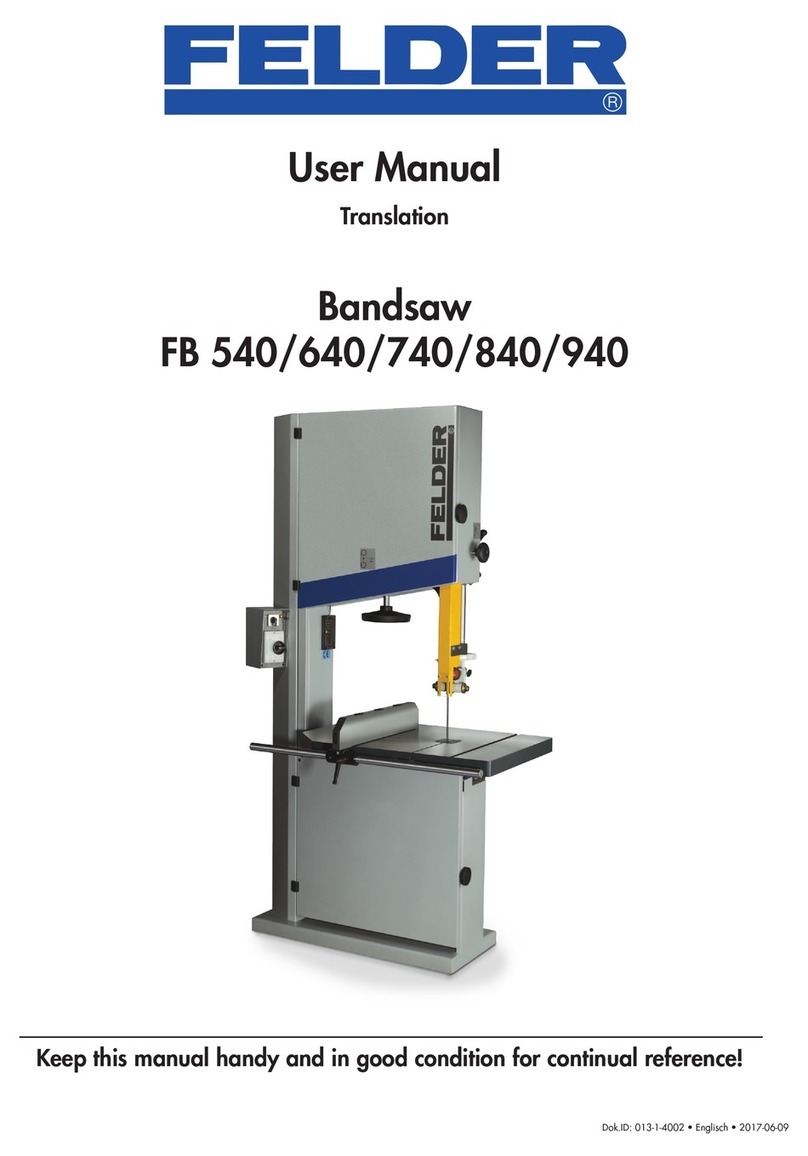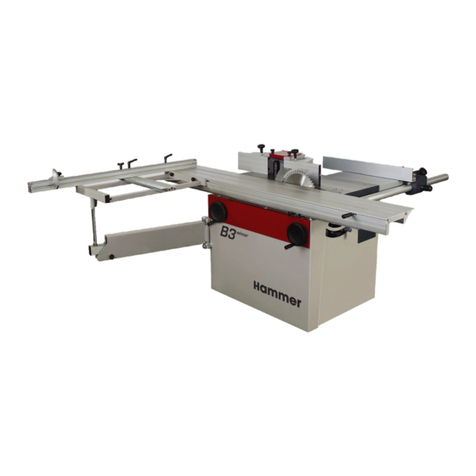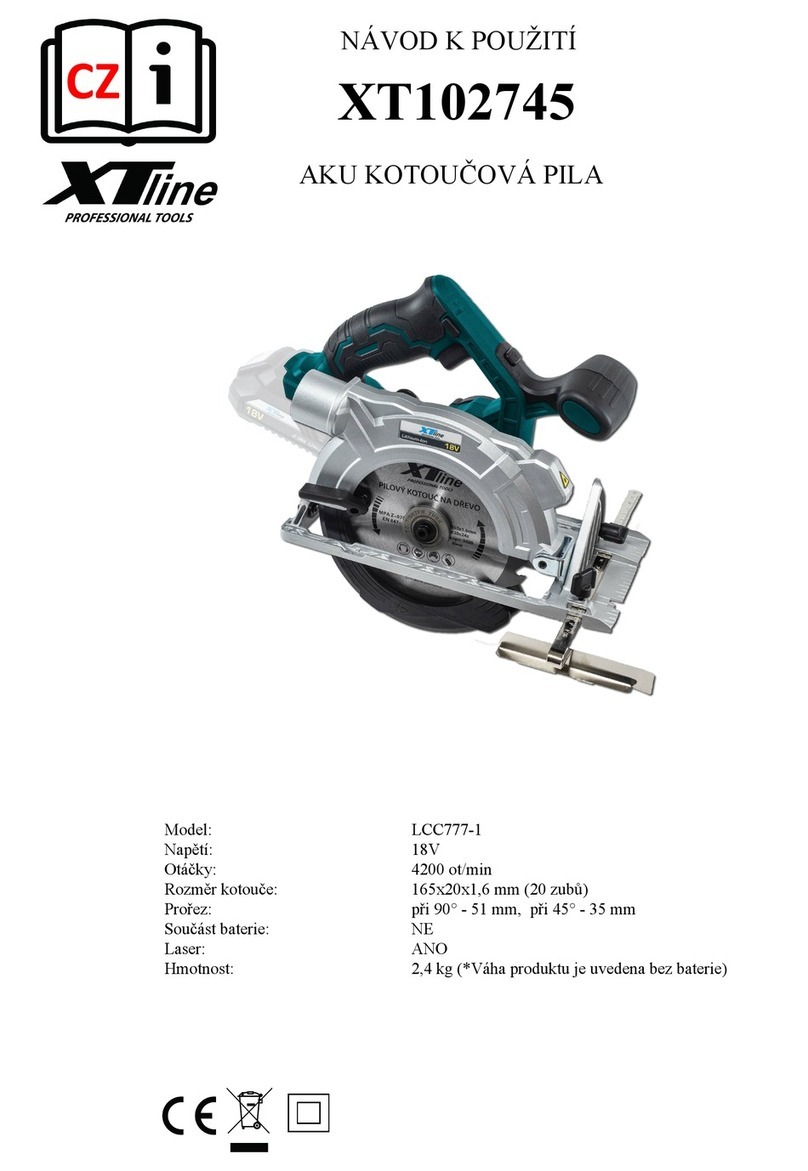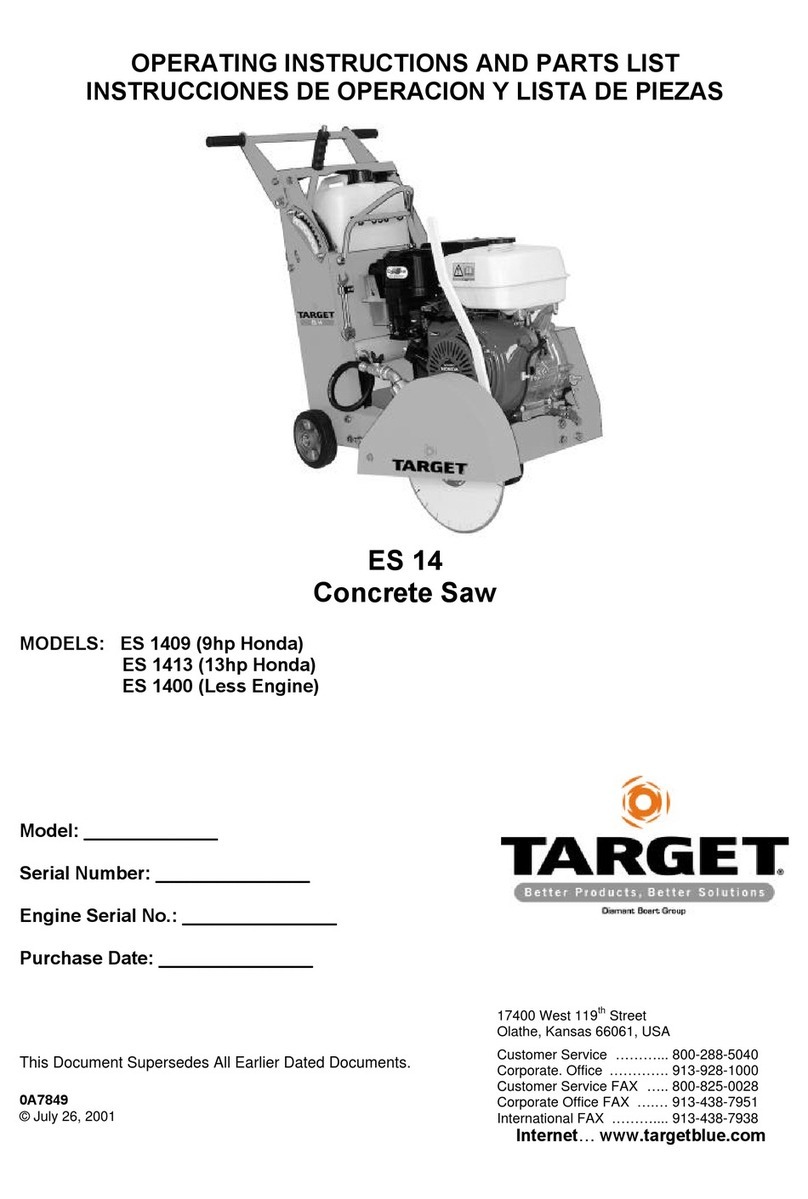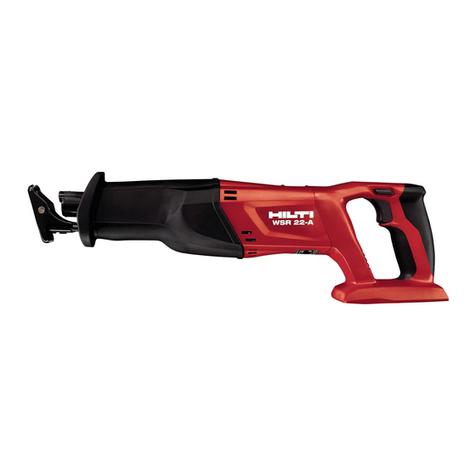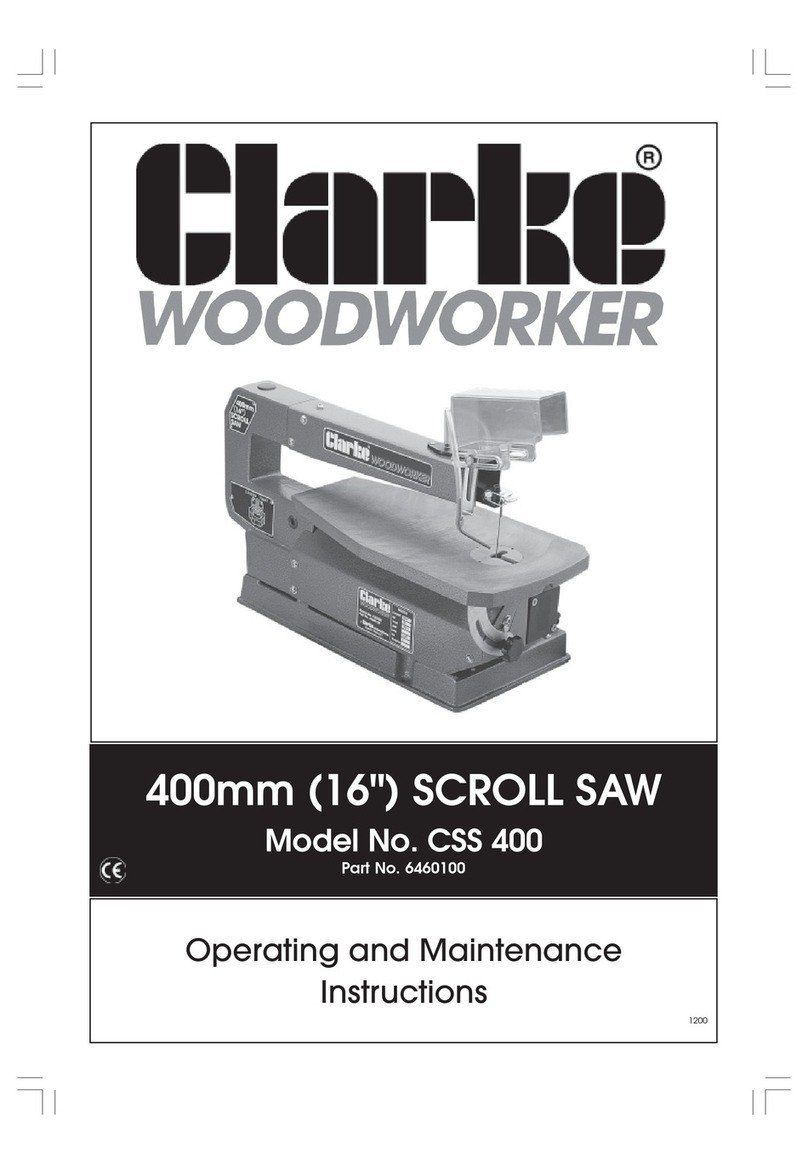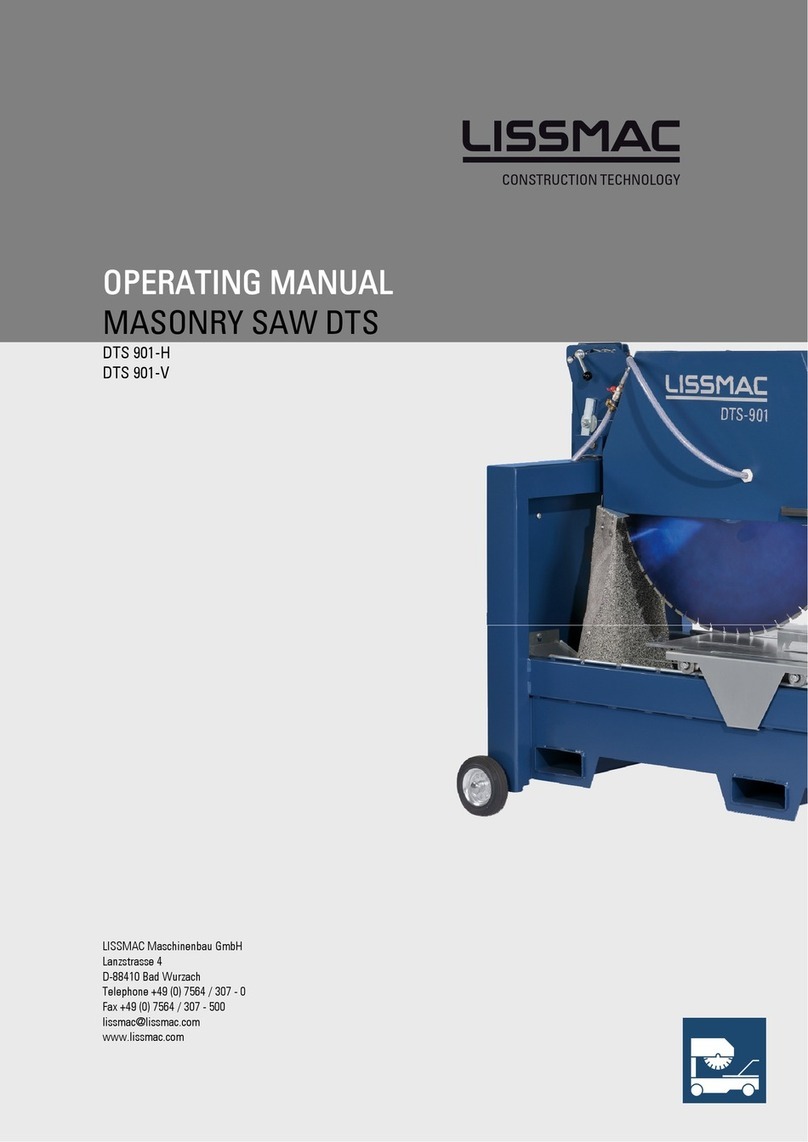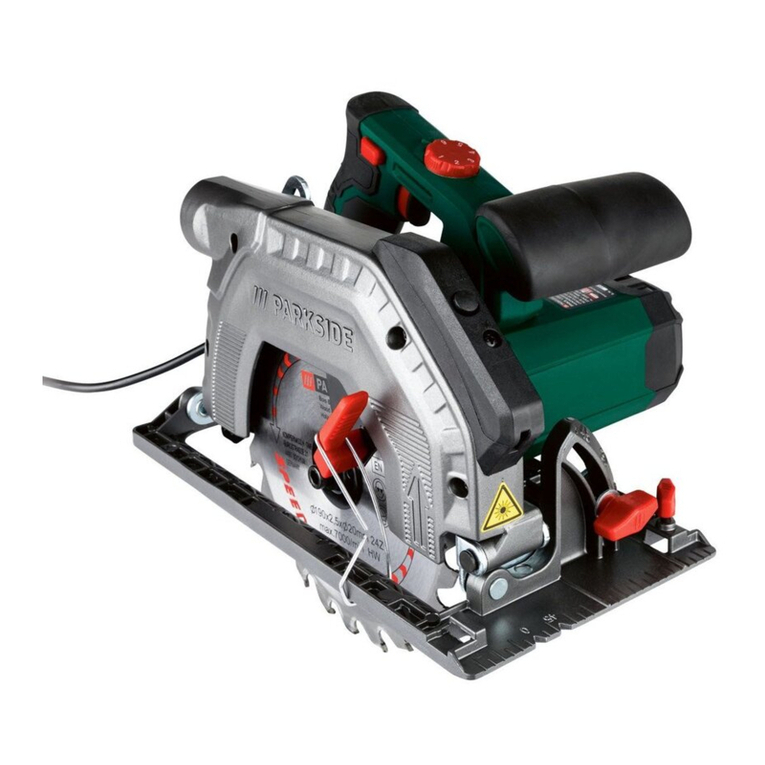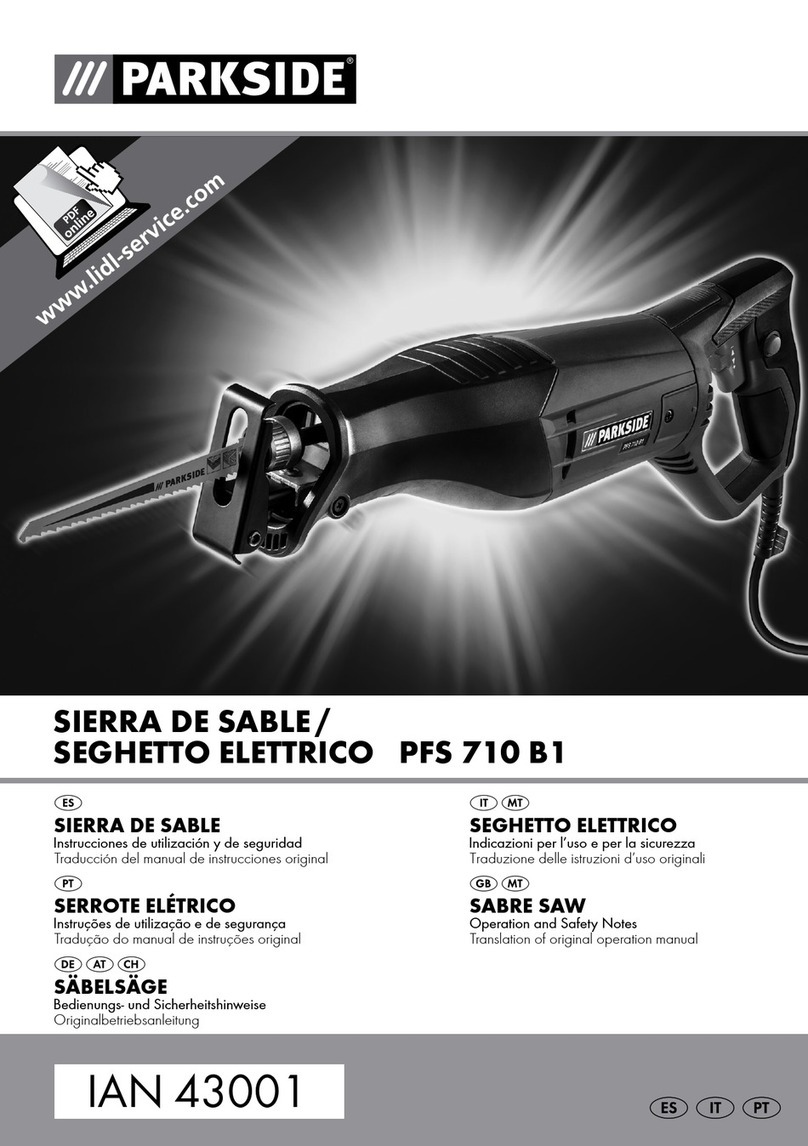Felder Hammer K3 basic User manual

User Manual
Panel Saw
K3 basic/K3 winner/K3 e-classic
Keep this manual handy and in good condition for continual reference!
Dok.ID: 503010-902_02 • Englisch • 2022-11-14
GER = Original operating manual language
Other languages = Translation of the original operating manual

2
FELDER KG
KR-Felder-Straße 1, 6060 Hall in Tirol, AUSTRIA
+43 (0) 5223 / 58 50 0
+43 (0) 5223 / 56 13 0
info@felder-group.com
www.felder-group.com
Panel Saw
K3 basic/K3 winner/K3 e-classic
Attention: The machine must be inspected immediately on arrival. If the machine was damaged during trans-
port or if any parts are missing, a written record of the problems must be submitted to the forwarding agent
and a damage report compiled. Be sure also to notify your supplier immediately.
For the safety of all personnel, it is necessary to conscientiously study this manual before assembly and com-
missioning. This manual must be kept in good condition, as it belongs to the machine! Furthermore, keep the
manual to hand and in the vicinity of the machine so that it is accessible to personnel when they are using,
maintaining or repairing the machine.
Hammer A product of the FELDER GROUP!
Note: Year of construction
The machine number of this machine will be printed on this operating manual.
The final two digits of the machine number show the year of construction of this machine.
z.B. XXX.XX.XXX.22 -> Year of construction 2022
Important Notices!
Please note, that depending on the model of the machine, not all described functions are present, or addi-
tional functions and buttons are available (e.g. machines with special functions).

3
Panel Saw
K3 basic/K3 winner/K3 e-classic
Table of Contents
1 General .......................................................................................................................6
1.1 Explanation of symbols ...................................................................................................6
1.2 Information about the manual ..........................................................................................6
1.3 Liability and warranty .....................................................................................................7
1.4 Copyright ......................................................................................................................7
1.6 Spare parts ...................................................................................................................7
1.7 Disposal ........................................................................................................................8
2 Safety .........................................................................................................................9
2.1 Intended use ..................................................................................................................9
2.2 Manual contents ............................................................................................................9
2.3 Making changes and modifications to the machine.............................................................9
2.4 Responsibilities of the owner operator .............................................................................10
2.5 What is required of personnel ........................................................................................10
2.6 Work safety ................................................................................................................10
2.7 Personal safety .............................................................................................................11
2.8 Hazards arising from the machine ..................................................................................11
2.9 Other risks ..................................................................................................................12
3 Declaration of Conformity ..........................................................................................13
4 Specifications ............................................................................................................15
4.1 Dimensions and weight .................................................................................................15
4.1.1 K3 basic/K3 e-classic ...............................................................................................................15
4.1.2 K3 winner ...............................................................................................................................16
4.2 Operation and storage conditions ..................................................................................17
4.3 Electrical connection .....................................................................................................17
4.4 Drive motor .................................................................................................................17
4.5 Particle emissions .........................................................................................................18
4.6 Noise emission ............................................................................................................18
4.7 Chip extraction ............................................................................................................18
4.8 Tools ..........................................................................................................................19
5 Setting up the machine ..............................................................................................20
5.1 Overview ....................................................................................................................20
5.1.1 K3 basic/K3 e-classic ...............................................................................................................20
5.1.2 K3 winner ...............................................................................................................................21
5.2 Accessories .................................................................................................................22
5.3 Data plate ...................................................................................................................24
5.4 Main switch .................................................................................................................25
5.5 Safety devices .............................................................................................................25
5.5.1 Safety break switches ................................................................................................................25
5.5.2 Sliding table catch ....................................................................................................................26
5.5.3 Saw guard ..............................................................................................................................26
5.6 Operation and display elements ....................................................................................26
Table of Contents

4
Panel Saw
K3 basic/K3 winner/K3 e-classic
6 Transport, packaging and storage ..............................................................................27
6.1 Safety instructions ........................................................................................................27
6.2 Transport .....................................................................................................................27
6.2.1 Transport locking device ............................................................................................................28
6.2.2 Transport devices for the circular saw K3 basic ...........................................................................28
6.2.3 Transport with a crane...............................................................................................................29
6.2.4 Transport with a fork lift truck .....................................................................................................29
6.2.5 Transport with a pallet jack ........................................................................................................30
6.2.5.1 Unloading ............................................................................................................................30
6.2.5.2 Transporting the machine ........................................................................................................30
6.2.6 Transport with a rolling carriage .................................................................................................31
6.3 Transport inspection ......................................................................................................31
6.4 Packaging ...................................................................................................................31
6.5 Storage .......................................................................................................................32
7 Setup and installation ................................................................................................33
7.1 Safety instructions ........................................................................................................33
7.2 Installation ...................................................................................................................33
7.3 Assembly ....................................................................................................................35
7.3.1 Sliding table ............................................................................................................................35
7.3.2 Assembling/disassembling the outrigger table..............................................................................35
7.3.3 Circular saw guard ...................................................................................................................36
7.4 Chip extraction ............................................................................................................36
7.5 Electrical connection .....................................................................................................37
8 Making adjustments and preparations ........................................................................38
8.1 Safety instructions ........................................................................................................38
8.2 Sliding table catch .......................................................................................................38
8.3 Crosscut fence on the sliding table .................................................................................39
8.4 Crosscut fence on the outrigger ......................................................................................39
8.5 Cross stop ...................................................................................................................40
8.6 Crosscut fence-extension ...............................................................................................41
8.7 Parallel cutting fence .....................................................................................................41
8.7.1 Sliding ....................................................................................................................................41
8.7.2 Fine adjustment (Option)............................................................................................................42
8.7.3 Modifying the guide ................................................................................................................43
8.7.4 Removal ..................................................................................................................................43
8.7.5 Swinging out............................................................................................................................44
8.8 Setting the height/angle of cut .......................................................................................44
8.9 Tool change ................................................................................................................45
8.9.1 Preparing to change tooling .......................................................................................................45
8.9.2 Preparing the machine to operate ...............................................................................................45
8.10 Changing the saw blade .............................................................................................46
8.10.1 Loosening/adjusting the splitter ................................................................................................47
8.10.2 Fitting in/changing the splitter ..................................................................................................47
8.10.3 Removing the splitter ...............................................................................................................48
8.10.4 Circular saw guard .................................................................................................................48
8.11 Grooving tools ...........................................................................................................49
8.11.1 Retooling to an operation with grooving tools .............................................................................49
8.11.2 Chucking the grooving tools .....................................................................................................50
8.11.3 Unchucking the grooving tools – Retool to a saw blade operation .................................................51
8.12 Scoring blade ............................................................................................................52
8.12.1 Assembling the scoring blade ..................................................................................................52
8.12.2 Adjusting the scoring unit ........................................................................................................53
8.12.3 Adjusting the width .................................................................................................................53
Table of Contents

5
Panel Saw
K3 basic/K3 winner/K3 e-classic
9 Operation .................................................................................................................54
9.1 Safety instructions ........................................................................................................54
9.2 Switching on the machine / Switching off the machine / Emergency-stop ............................55
9.3 Moving the sliding table ................................................................................................56
9.4 Work stations ..............................................................................................................56
9.5 Working techniques ......................................................................................................57
9.5.1 Permitted working techniques .....................................................................................................57
9.5.2 Prohibited working techniques ....................................................................................................57
9.5.3 General procedures for authorised working techniques ..................................................................57
9.5.4 Longitudinal cut ........................................................................................................................58
9.5.5 Trimming .................................................................................................................................58
9.5.6 Cutting battens .........................................................................................................................59
9.5.7 Cross-cutting at the crosscut fence (Sliding table) ..........................................................................60
9.5.8 Cross-cutting at the parallel cutting fence .....................................................................................61
9.5.9 Cutting smaller, narrower workpieces ..........................................................................................61
9.5.10 Cutting with an outrigger .........................................................................................................62
9.5.11 Groove cuts ...........................................................................................................................63
9.5.12 Working with grooving tools ....................................................................................................64
10 Maintenance ...........................................................................................................65
10.1 Safety instructions ......................................................................................................65
10.2 Maintenance schedule ................................................................................................65
10.3 Cleaning the bearing tracks .........................................................................................66
10.4 Lubricating the height spindle and tilting spindle circular saw ...........................................66
10.5 Tightening/replacing the drive belt ...............................................................................67
10.5.1 Tensioning the drive belt ..........................................................................................................67
10.5.2 Replacing the drive belt ...........................................................................................................67
10.6 Checking the scoring belt ............................................................................................68
10.7 Cleaning/changing the dust brush of the outrigger arm ..................................................68
10.8 Renewing the sliding table scraper blade (ball cage) ......................................................69
10.9 Dismantling the sliding table ........................................................................................69
10.10 Assembling the sliding table ......................................................................................70
11 Faults ......................................................................................................................72
11.1 Safety instructions ......................................................................................................72
11.2 What to do if a fault develops .....................................................................................72
11.3 What to do after rectifying the fault ..............................................................................72
11.4 Faults, causes and repairs ...........................................................................................73
11.5 Adjusting the parallel cutting fence guide height .............................................................73
11.6 Adjusting/correcting the parallel cutting fence angle .......................................................74
11.7 Aligning the sliding table ball cage ..............................................................................74
11.8 Adjusting the locking force of the parallel cutting fence ...................................................75
11.9 Professional rip-fence (Option) .....................................................................................75
11.9.1 Adjusting the circular saw fence guide ......................................................................................75
11.9.2 Adjusting the rip fence fine adjustment ......................................................................................76
11.9.3 Adjusting the locking force of the parallel cutting fence ...............................................................76
Table of Contents

6
!
Panel Saw
K3 basic/K3 winner/K3 e-classic
Attention:
This symbol marks tips and information which should be observed to ensure efficient and failure-free o-
peration of the machine.
Attention: Risk of material damage!
This symbol marks instructions which, if not observed, may lead to material damage, functional failures
and/or machine breakdown.
Warning: Risk of injury or death!
This symbol marks instructions that must be followed in order to avoid harm to one‘s health, injuries, per-
manent impairment or death.
1 General
1.1 Explanation of symbols
Important technical safety instructions in this manual are
marked with symbols.
These instructions for work safety must be followed. In all
these particular cases, special attention must be paid in
order to avoid accidents, injury to persons or material
damage.
Warning: Danger – electric current!
This symbol warns of potentially dangerous situations related to electric current. Not observing the safety
instructions increases the risk of serious injury or death. Required electrical repairs may only be carried out
by a trained electrical technician.
1.2 Information about the manual
This manual describes how to operate the machine
properly and safely. Be sure to follow the safety tips and
instructions stated here as well as any local accident
prevention directives and general safety regulations.
Before beginning any work on the machine, ensure that
the manual, in particular the chapter entitled „Safety“
and the respective safety guidelines, has been read in its
entirety and fully understood. This manual is an integral
part of the machine and must therefore be kept in the
direct vicinity of the machine and accessible at all times.
If the machine is sold, rented, lent or otherwise trans-
ferred to another party, the manual must accompany the
machine.
General

7
Panel Saw
K3 basic/K3 winner/K3 e-classic
1.3 Liability and warranty
The contents and instructions in this manual were com-
piled in consideration of current regulations and state of
the art technology as well as based on our know-how
and experience acquired over many years. This manual
must be read carefully before commencing any work on
or with this machine. The manufacturer shall not be liable
for damage and or faults resulting from the disregard of
instructions in the manual. The texts and images do not
necessarily represent the delivery contents. The images
and graphics are not depicted on a 1:1 scale. The actual
delivery contents are dependent on custom-build specifi-
cations, add-on options or recent technical modifications
and may therefore deviate from the descriptions, instruc-
tions and images contained in the manual. Should any
questions arise, please contact the manufacturer. We
reserve the right to make technical modifications to the
product in order to further improve user-friendliness and
develop its functionality.
1.4 Copyright
This manual should be handled confidentially. It is desig-
nated solely for those persons who work on or with the
machine. All descriptions, texts, drawings, photos and
other depictions are protected by copyright and other
commercial laws. Illegal use of the materials is punish-
able by law.
This manual – in its entirety or parts thereof – may not
be transferred to third parties or copied in any way or
form, and its contents may not be used or otherwise
communicated without the express written consent of the
manufacturer.
Infringement of these rights may lead to a demand for
compensation or other applicable claims. We reserve all
rights in exercising commercial protection laws.
1.5 Warranty notice
The guarantee period is in accordance with national
guidelines. Details may be found on our website,
www.felder-group.com
1.6 Spare parts
Use only genuine spare parts supplied by the manufac-
turer.
Attention: Non genuine, counterfeit or faulty spare parts may result in damage, cause malfunction or com-
plete breakdown of the machine.
If unauthorised spare parts are installed in the machine,
all warranty, service, compensation and liability claims
against the manufacturer and their contractors, dealers
and representatives shall be rejected.
Attention: The original spare parts that have been authorised for use are listed in a separate spare parts cata-
logue, enclosed in the documentation package supplied with the machine.
General

8
Panel Saw
K3 basic/K3 winner/K3 e-classic
1.7 Disposal
If the machine is to be disposed of, separate the com-
ponents into the various materials groups in order to
allow them to be reused or selectively disposed of. The
whole structure is made of steel and can therefore be
dismantled without problem. This material is also easy
to dispose of and does not pollute the environment or
Attention: Used electrical materials, electronic components, lubricants and other auxiliary substances must be
treated as hazardous waste and may only be disposed of by specialised, licensed firms.
jeopar-dise public health. International environmental
regulations and local disposal laws must always be
complied with.
General

9
Panel Saw
K3 basic/K3 winner/K3 e-classic
2 Safety
At the time of its development and production, the ma-
chine was built in accordance with prevailing technologi-
cal regulations and therefore conforms to industry safety
standards.
However, hazards may arise should the machine be
operated by untrained personnel, be used improperly or
employed for purposes other than those it was designed
for. The chapter entitled „Safety“ offers an overview of
all the important safety considerations necessary to opti-
mise safety and ensure the safe and trouble-free opera-
tion of the machine.
Additionally, in order to further minimise risks, the other
chapters of this manual contain specific safety instruc-
tions, all marked with symbols. Besides the various
instructions, there are a number of pictograms, signs and
labels affixed to the machine that must also be heeded.
These must be kept visible and legible and may not be
removed.
2.1 Intended use
The HAMMER K3 basic/K3 winner circular saw is only
to be used to machine wood or other machinable mate-
rials. Working materials other than wood is only permit-
ted with the express written consent of the manufacturer.
Operational safety is guaranteed only when the machine
is used for its intended purposes.
Attention: Any other application above and beyond the intended purposes is considered improper use and is
therefore not permitted. All claims regarding damage resulting from improper use that are made against the
manufacturer and its authorized representatives shall be rejected. The operator shall be solely liable for any
damage that results from improper use of the machine.
The term „proper use“ also refers to correctly observing
the operating conditions as well as the specifications and
instructions in this manual.
The machine may only be operated with parts and origi-
nal accessories from the manufacturer.
2.2 Manual contents
All those appointed to work on or with the machine must
have fully read and understood the manual before com-
mencing any work. This requirement must be met even
if the appointed person is familiar with the operation of
such a machine or a similar one, or has been trained by
the manufacturer.
Knowledge about the contents of this manual is a
prerequisite for protecting personnel from hazards and
avoiding mistakes so that the machine may be operated
in a safe and trouble-free manner. It is recommended
that the operator requests proof from the personnel that
the contents of the manual have in fact been read and
understood.
2.3 Making changes and modifications to the machine
In order to minimise risks and to ensure optimal perform-
ance, it is strictly prohibited to alter, retrofit or modify the
machine in any way without the express consent of the
manufacturer.
All the pictograms, signs and labels affixed to the
machine must be kept visible, readable and may not be
removed. Pictograms, signs and labels that have become
damaged or unreadable must be replaced promptly.
Safety

10
Panel Saw
K3 basic/K3 winner/K3 e-classic
2.4 Responsibilities of the owner operator
This manual must be kept in the immediate vicinity of
the machine and be accessible at all times to all persons
working on or with the machine. The machine may only
be operated if it is in proper working order and in safe
condition. Every time before the machine is switched
on, it must be inspected for visible defects and general
condition. All instructions in this manual must be strictly
followed without reservation.
Besides the safety advice and instructions stated in this
manual, it is necessary to consider and observe local ac-
cident prevention regulations, general safety regulations
as well as current environmental stipulations that apply to
the operational range of the machine.
The operator and designated personnel are responsible
for the trouble-free operation of the machine as well
as for clearly establishing who is in charge of insta-
lling, servicing, maintaining and cleaning the machine.
Machines, tools and accessories must be kept out of the
reach of children.
2.5 What is required of personnel
Only authorized and trained personnel may work on and
with the machine. Personnel must be briefed about all
functions and potential dangers of the machine. „Spe-
cialist staff“ is a term that refers to those who – due to
their professional training, know-how, experience, and
knowledge of relevant regulations – are in a position to
assess delegated tasks and recognise potential risks. If
the personnel lack the necessary knowledge for work-
ing on or with the machine, they must first be trained.
Responsibility for working with the machine (installation,
service, maintenance, overhaul) must be clearly defined
and strictly observed. Only those persons who can be
expected to carry out their work reliably may be given
permission to work on or with the machine. Personnel
must refrain from working in ways that could harm oth-
ers, the environment or the machine itself. It is absolutely
forbidden for anyone who is under the influence of
drugs, alcohol or reaction-impairing medication to work
on or with the machine. When appointing personnel to
work on the machine, it is necessary to observe all local
regulations regarding age and professional status. The
user is also responsible for ensuring that unauthorised
persons remain at a safe distance from the machine.
Personnel are obliged to immediately report to the opera-
tor any irregularities with the machine that might compro-
mise safety.
2.6 Work safety
Following the safety advice and instructions given in this
manual can prevent bodily injury and material dam-
age while working on and with the machine. Failure to
observe these instructions can lead to bodily injury and
damage to or destruction of the machine. Disregard of
the safety advice and instructions given in this manual as
well as the accident prevention regulations and general
safety regulations applicable to the operative range of
the machine shall release the manufacturer and their
authorised representatives from any liability and from all
compensation claims.
Safety

11
Panel Saw
K3 basic/K3 winner/K3 e-classic
2.7 Personal safety
When working on or with the machine, the following
must be strictly observed:
Protective gear (overalls, safety goggles, dust mask, hairnet to contain long hair, etc.)
Sturdy, tight-fitting clothing (tear-resistant, no wide sleeves).
Persons with long hair who are not wearing a hairnet are not permitted to work on or with the machine.
It is prohibited to wear gloves while working on or with the machine.
All jewellery (rings, bracelets, necklaces, etc.) must be removed before starting work on or with the ma-
chine.
When working on or with the machine, the following must always be worn by personnel:
Protective footwear
That protects the feet from heavy falling objects and prevents sliding on slippery floors.
Ear protection
To protect against loss of hearing.
2.8 Hazards arising from the machine
The machine has undergone a hazards analysis. The
design and construction of the machine are based on the
results of this analysis and correspond to state-of-the-art
technology.
The machine is considered operationally safe when used
properly.
Nevertheless, there are some residual risks that must be
considered.
The machine runs with high electrical voltage.
Warning! Danger – electric current: Electrical energy can cause serious bodily injury. Damaged insulation
materials or defective individual components can cause a life-threatening electrical shock.
• Before carrying out any maintenance, cleaning and
repair work, switch off the machine and secure it
against being accidentally switched on again.
• When carrying out any work on the electrical equip-
ment, ensure that the voltage supply is completely
isolated.
• Do not remove any safety devices or alter them to put
them out of commission.
Safety

12
Panel Saw
K3 basic/K3 winner/K3 e-classic
2.9 Other risks
Warning: Even if the safety measures are followed, there are still certain residual risks that must be consi-
dered when working on the machine:
• Risk of cutting injuries, especially when changing the
tooling
• Contact with the rotating saw blade and/or the scor-
ing unit can cause an injury
• Risk of injury due to ejected workpieces
• Risk of injury from workpiece kickback
• Hearing damage as a result of high noise levels
• Health impairments due to the inhalation of airborne
particles, especially when working with beech and
oak wood
• Risk of squashing, catching, reeling, pushing, cutting
or slicing off
Safety

13
Hall in Tirol, 1.10.2022 Prof. h.c. Ing. Johann Georg Felder
CEO FELDER KG
KR-Felder-Straße 1, 6060 Hall in Tirol, AUSTRIA
Panel Saw
K3 basic/K3 winner/K3 e-classic
Manufacturer: FELDER KG
KR-FELDER-STR.1
A-6060 Hall in Tirol
Product designation: Panel Saw
Make: Hammer
Model designation: K3 basic/K3 winner/K3 e-classic
The following EC guidelines were applied: 2006/42/EG
2014/30/EU
The following harmonised norms were applied: EN ISO 19085-1
EN ISO 19085-5
3 Declaration of Conformity
Declaration of Conformity
Note: Machine number
The machine number of this machine will be printed on the cover sheet of this operating manual.
EG-Declaration of Conformity
According to Machine Guidelines 2006/42/EG
We hereby declare that the machine indicated below, which corresponds to the design and construction of the model
we placed on the market, conforms with the health and safety requirements as stated by the EC guidelines (see table).
This EC Declaration of Conformity is valid only if the CE label has been affixed to the machine.
Modifying or altering the machine without the express written agreement of the manufacturer shall render the war-
ranty null and void.
The signatory of this statement is the appointed agent for
the compilation of the technical information

14
Panel Saw
K3 basic/K3 winner/K3 e-classic
Manufacturer: FELDER KG
KR-FELDER-STR.1
A-6060 Hall in Tirol
Product designation: Panel Saw
Make: Hammer
Model designation: K3 basic/K3 winner/K3 e-classic
The following UK guidelines were applied: S.I. 2008/1597
S.I. 2016/1091
The following harmonised norms were applied: EN ISO 19085-1
EN ISO 19085-5
This Declaration of Conformity is valid only if the UKCA label has been affixed to the machine.
Modifying or altering the machine without the express written agreement of the manufacturer shall render the war-
ranty null and void.
The signatory of this statement is the appointed agent for
the compilation of the technical information
Note: Machine number
The machine number of this machine will be printed on the cover sheet of this operating manual.
Declaration of Conformity
According to UK Directive S.I. 2008/1597
We hereby declare that the machine indicated below, which corresponds to the design and construction of the model
we placed on the market, conforms with the health and safety requirements as stated by the UK guidelines (see table).
Prof. h.c. Ing. Johann Georg Felder
CEO FELDER KG
KR-Felder-Straße 1, 6060 Hall in Tirol, AUSTRIA
Declaration of Conformity
Hall in Tirol, 1.10.2022

15
A1 A2B
C2
C1
D
E
Panel Saw
K3 basic/K3 winner/K3 e-classic
Machine Standard Option
Sliding table length A950 mm 1250 mm
Sliding table travel distance A1 459 mm 764 mm
Sliding table travel distance A2 660 mm 1028 mm
total length A1 + B + A2 2035 mm 2708 mm
Length: Machine table + bar B916 mm
Overall width C1 844 mm
Overall width (Option) C2 892 mm 1743 mm
Total height / Working height (approx.) 1070 / 888 mm
Rip capacity D700 mm
Width of sliding table E290 mm
Net weight *) 240 kg
Machine including packaging
Length x Width **) 1200 x 800 mm
Height 1200 mm
Weight (approx.)* 310 kg
*) with average-sized equipment
**) The transport width measures under 800 mm. This makes it possible to transport the machine through doorways.
4 Specifications
Fig. 4-1: Dimensions K3 basic/K3 e-classic
4.1 Dimensions and weight
Specifications
4.1.1 K3 basic/K3 e-classic

16
A1 A2
C1
C2
B
D
C3
E
C4
Panel Saw
K3 basic/K3 winner/K3 e-classic
Standard
K3 winner Option
K3 winner Standard
K3 winner
comfort
Option
K3 Winner
comfort
Machine
Sliding table length A1250 mm 2000 mm 2000 mm -
Sliding table travel distance A1 770 mm 1520 mm 1520 mm -
Sliding table travel distance A2 907 mm 1698 mm 1698 mm -
total length A1 + B + A2 2708 mm 4250 mm 4250 mm -
Length: Machine table + bar B1032 mm 1032 mm
Overall width C1 1034 mm 1474 mm 1034 mm 1474 mm
Overall width C2 892 (mm 1743 mm - 892 (1743) mm
Overall width (Option) C3 - 1364 (2140) mm 1364 mm 2140 mm
Overall width C4 - 1066 mm 1066 mm
Total height / Working height (approx.) 1070 / 888 mm 1070 / 888 mm
Rip capacity D800 mm 1250 mm 800 mm 1250 mm
Width of sliding table E290 mm 290 mm
Net weight *) 280 kg 280 kg
Machine including packaging
Length x Width **) 1470 x 1160 mm 2100 x 1200 mm
Height 1200 mm 1200 mm
Weight (approx.)* 350 kg 350 kg
*) with average-sized equipment
Specifications
4.1.2 K3 winner
Fig. 4-2: Dimensions K3 winner

17
Panel Saw
K3 basic/K3 winner/K3 e-classic
Circular saw drive / Spindle moulder unit Alternating-current motor Three-phase current motor
Motor voltage 1x 230 V 3x 230 V / 3x 400 V
motor frequency 50/60 Hz 50/60 Hz
System of protection IP 55 IP 55
K3 Winner/Winner comfort
Motor power S6-40 %*)- 3 kW
Motor power S6-40 % - Option*) 3 kW 4 kW
K3 e-classic
Motor power S6-40 %*)- 3 kW (3 x400 V)
Motor power S6-40 % - Option*) 3 kW -
Antriebsmotor Vorritzeinheit (Option)
Motor power S6-40 %*)0,65 kW**)0,65 kW
*) S6 = Last- und Aussetzbetrieb; 40% = relative Einschaltdauer
**) Schnitthöhe maximal: 2 mm
Specifications
4.3 Electrical connection
4.4 Drive motor
The actual values can be found on the data plate.
4.2 Operation and storage conditions
Operating/room temperature +10° to +40°C
Storage temperature –10° to +50 °C
mains voltage according to specification plate ±10%
Safeguarding see circuit plan
Power supply cord (H07RN-F) 3x2,5 mm²/ 5x2,5 mm²
Triggering characteristic C (D*)
*) if starting up is slow, caused by large swinging masses

18
99 102
87 90
Panel Saw
K3 basic/K3 winner/K3 e-classic
aggregate Saw guard
Dust extraction outlet, Ø 120 mm 50 mm
Min. air speed 20 m/s 20 m/s
Min. vacuum 1824 Pa 953 Pa
Min. volume flow (at 20 m/s) 814 m³/h 141m³/h
4.7 Chip extraction
Specifications
4.6 Noise emission
The specified values are emission values and therefore
do not represent safe workplace values. Even though a
relationship exists between particle emission and noise
emission levels, an inference cannot be made about
whether additional safety measures need to be imple-
mented. Factors which can significantly affect the emis-
sion level that presently exists at the workplace include
duration of the effect, characteristics of the workspace,
and other ambient influences. The permissible workplace
values may also differ from country to country. Neverthe-
less, this information is provided to help the operator bet-
ter assess hazards and risks. Depending on the location
of the machine and other specific conditions, the actual
noise emission values may deviate significantly from the
specified values.
Note:
To keep the noise emission as low as possible, always use sharpened tools and operate the machine at the
correct speed.
Ear protection must always be worn; however, such protection cannot be considered a substitute for properly
sharpened tools.
All values in dB(A) and with a measurement uncertainty factor of 4 dB(A).
Idle Working
Sound power level
(EN ISO 3746)
Workplace emissions values
(EN ISO 11202)
4.5 Particle emissions
The working areas of this machine comply to DGUV
Information 209-044 and are classed as dust reduced.
The maximum concentration level of 2 mg/m³ of inhala-
ble dust in the air will not be exceeded.
This only applies if the conditions that are specified in
the section >Extraction< are adhered to.
See chapter entitled >Setup and installation<

19
Ø 58 ± 0,1mm
Ø 8,5 ±0,3 mm
Ø 30 mm
Ø 46,35 ± 0,1mm
Ø 9 ±0,3 mm
Ø 30 mm
Panel Saw
K3 basic/K3 winner/K3 e-classic
Saw blades
Diameter 250 – 315 mm
Bore with lug 30 mm
constant rotation 4800 min-1
Max. cutting height (with a saw blade-diameter 315
mm) 103 mm
Saw blade tiltable from 90° to 45°
Scoring blades
Max. diameter 80 mm*)
Bore 20 mm
constant rotation 10000 min-1
Max. cutting height 4 mm
*) in combination with a 250 mm main saw blade
Slotting Cutters CE-Specifications
Max. diameter 180 mm
Width 5 to 20 mm
4.8 Tools
Specifications
Note: We recommend that only original HAMMER tools are used (HAMMER catalogue).
Only use saw blades
• Which have an authorised speed higher than the
speed of the saw arbor
• which conform to DIN EN 847-1 standards
Only use grooving tools designed for wood purposes!
Warning! Risk of injury!
Never exceed the maximum speed indicated on the tool!
Note: Max. cutting height
The maximum cutting height is directly related to the following factors:
• Type of wood (hardwood or softwood
• Wood dampness
• Feeding speed
• Saw blades
• The motor power of your machine
Sketches: Saw blade
Bore with lug

20
!
"
#
$
%
&
/
(
)
Panel Saw
K3 basic/K3 winner/K3 e-classic
5 Setting up the machine
5.1 Overview
Fig. 5-1: Overview
!Dust extraction (Connection D = 120 mm)
"Machine frame
#Sliding table
$Machine table
%Splitter
&Saw blade
/Saw guard with dust extraction (Connection D = 50 mm)
(Parallel cutting fence
)Crosscut fence (Sliding table)
Setting up the machine
5.1.1 K3 basic/K3 e-classic
This manual suits for next models
2
Table of contents
Other Felder Saw manuals
